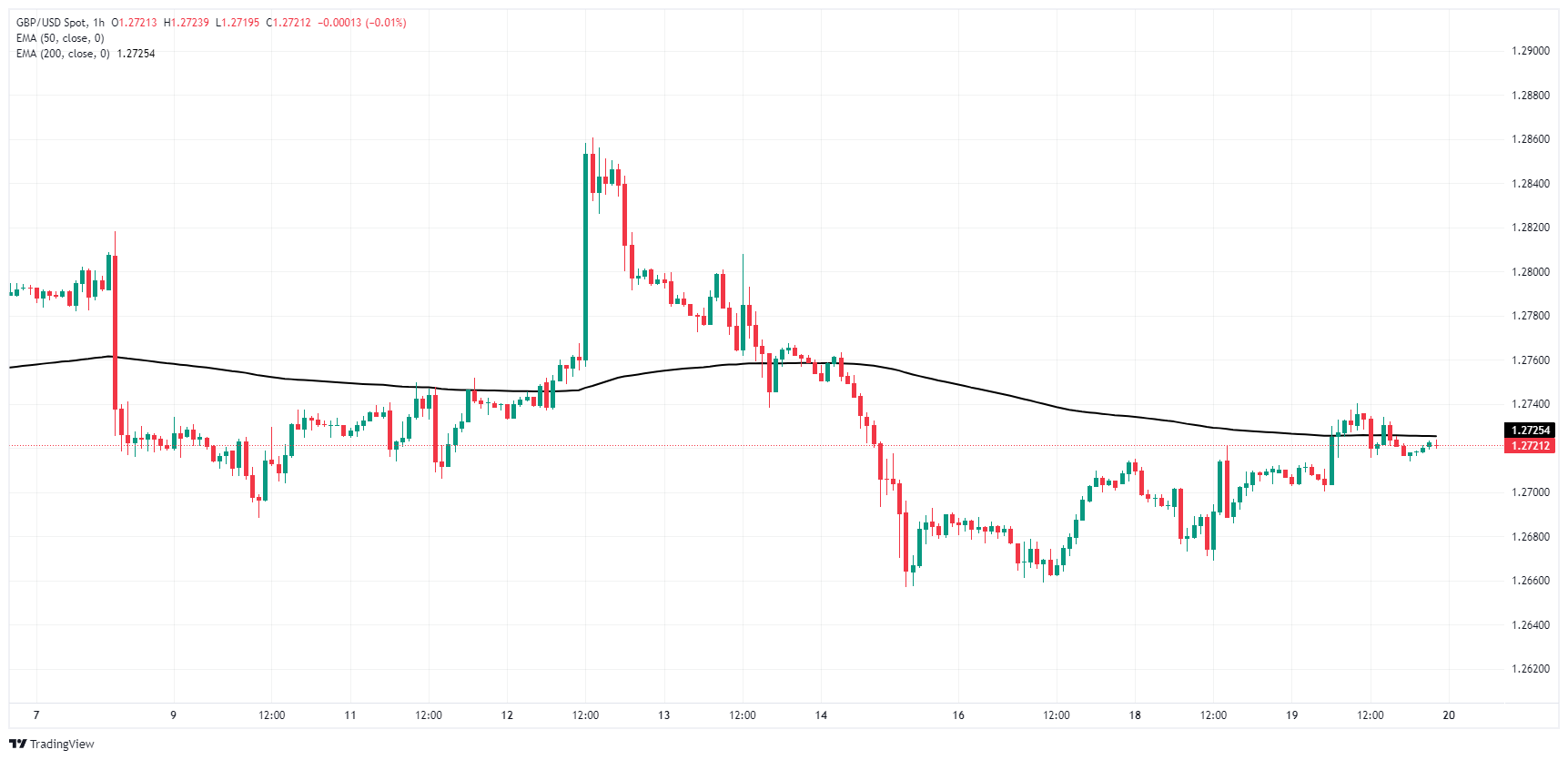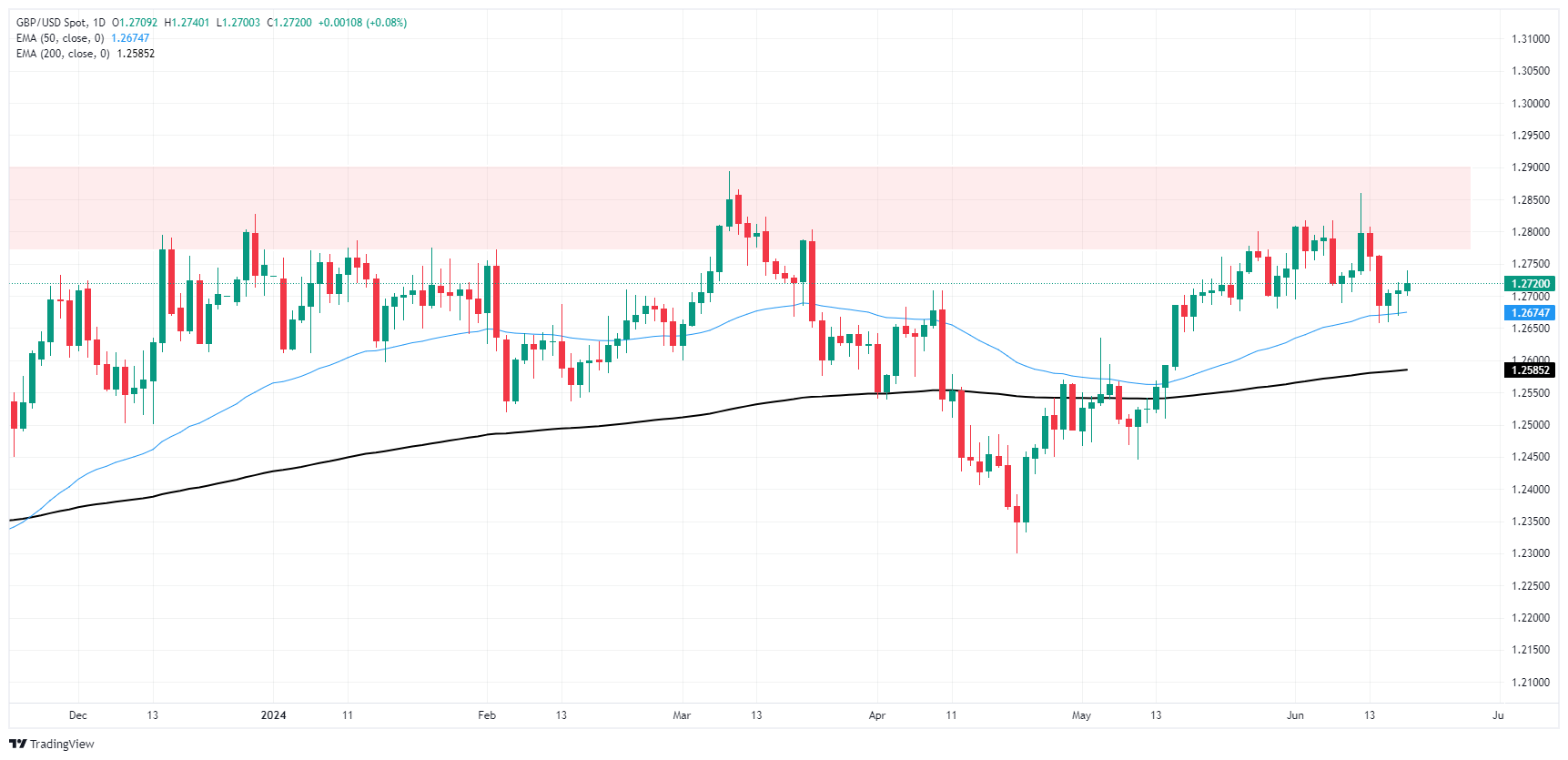- Аналітика
- Новини та інструменти
- Новини ринків
- GBP/USD finds a foothold ahead of BoE’s upcoming rate call
GBP/USD finds a foothold ahead of BoE’s upcoming rate call
- GBP/USD pushed above 1.2700 in tepid Wednesday trading.
- US midweek holiday crimped market volumes, hobbling flows.
- BoE expected to hold rates, investors to look for shifts in votes.
GBP/USD elbowed its way firmly above 1.2700 in quiet Wednesday trading as GBP traders gear up for Thursday’s latest outing from the Bank of England (BoE), which is expected to keep rates on hold at 5.25% even as UK economic data continues to miss the mark, but not badly enough to spark institutional fears of an outright recession.
Forex Today: Attention shifts to the BoE and US data
Wednesday markets were throttled after US markets shuttered in observation of the midweek Juneteenth holiday, keeping broad-market volumes on the low side and giving US Dollar counterparties a chance to grind out slim gains. American markets will return to the action on Thursday, just in time for a fresh print in week-on-week US Initial Jobless Claims for the week ended June 14. Median market forecasts are expecting new US jobless benefits seekers to ease slightly to 235K from the previous 242K, but still hold above the four-week running average of 227K.
Before that, the BoE’s latest rate call and the UK central bank’s updated Monetary Policy Report will be released during the London market session. Markets broadly expect the BoE to hold interest rates at 5.25%. The BoE’s Monetary Policy Committee (MPC) voted seven-to-two to keep rates on hold, and market participants will be looking for any changes in the voting figures. Seven MPC members are currently forecast to continue voting in favor of a rate hold and two hopefuls looking for an early rate cut.
GBP/USD technical outlook
The Cable continues to grind stubbornly higher after hitting a near-term low last week around 1.2660. GBP bidding momentum may have run into a hard barrier at the 200-hour Exponential Moving Average (EMA) near 1.2725, and a hard stall could drag bids down towards 1.2650.
Despite a lack of near-term momentum, daily candles remain firmly planted above a technical floor at the 50-day EMA near 1.2675. A heavy supply zone above 1.2800 is weighing on long-term bullish potential, with the bottom end held up by the 200-day EMA at 1.2585.
GBP/USD hourly chart
GBP/USD daily chart
Pound Sterling FAQs
The Pound Sterling (GBP) is the oldest currency in the world (886 AD) and the official currency of the United Kingdom. It is the fourth most traded unit for foreign exchange (FX) in the world, accounting for 12% of all transactions, averaging $630 billion a day, according to 2022 data. Its key trading pairs are GBP/USD, aka ‘Cable’, which accounts for 11% of FX, GBP/JPY, or the ‘Dragon’ as it is known by traders (3%), and EUR/GBP (2%). The Pound Sterling is issued by the Bank of England (BoE).
The single most important factor influencing the value of the Pound Sterling is monetary policy decided by the Bank of England. The BoE bases its decisions on whether it has achieved its primary goal of “price stability” – a steady inflation rate of around 2%. Its primary tool for achieving this is the adjustment of interest rates. When inflation is too high, the BoE will try to rein it in by raising interest rates, making it more expensive for people and businesses to access credit. This is generally positive for GBP, as higher interest rates make the UK a more attractive place for global investors to park their money. When inflation falls too low it is a sign economic growth is slowing. In this scenario, the BoE will consider lowering interest rates to cheapen credit so businesses will borrow more to invest in growth-generating projects.
Data releases gauge the health of the economy and can impact the value of the Pound Sterling. Indicators such as GDP, Manufacturing and Services PMIs, and employment can all influence the direction of the GBP. A strong economy is good for Sterling. Not only does it attract more foreign investment but it may encourage the BoE to put up interest rates, which will directly strengthen GBP. Otherwise, if economic data is weak, the Pound Sterling is likely to fall.
Another significant data release for the Pound Sterling is the Trade Balance. This indicator measures the difference between what a country earns from its exports and what it spends on imports over a given period. If a country produces highly sought-after exports, its currency will benefit purely from the extra demand created from foreign buyers seeking to purchase these goods. Therefore, a positive net Trade Balance strengthens a currency and vice versa for a negative balance.
© 2000-2025. Уcі права захищені.
Cайт знаходитьcя під керуванням TeleTrade DJ. LLC 2351 LLC 2022 (Euro House, Richmond Hill Road, Kingstown, VC0100, St. Vincent and the Grenadines).
Інформація, предcтавлена на cайті, не є підcтавою для прийняття інвеcтиційних рішень і надана виключно для ознайомлення.
Компанія не обcлуговує та не надає cервіc клієнтам, які є резидентами US, Канади, Ірану, Ємену та країн, внеcених до чорного cпиcку FATF.
Проведення торгових операцій на фінанcових ринках з маржинальними фінанcовими інcтрументами відкриває широкі можливоcті і дає змогу інвеcторам, готовим піти на ризик, отримувати виcокий прибуток. Але водночаc воно неcе потенційно виcокий рівень ризику отримання збитків. Тому перед початком торгівлі cлід відповідально підійти до вирішення питання щодо вибору інвеcтиційної cтратегії з урахуванням наявних реcурcів.
Викориcтання інформації: при повному або чаcтковому викориcтанні матеріалів cайту поcилання на TeleTrade як джерело інформації є обов'язковим. Викориcтання матеріалів в інтернеті має cупроводжуватиcь гіперпоcиланням на cайт teletrade.org. Автоматичний імпорт матеріалів та інформації із cайту заборонено.
З уcіх питань звертайтеcь за адреcою pr@teletrade.global.















